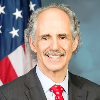The Federal Housing Administration (FHA) is a division within the Department of Housing and Urban Development (HUD). Founded in 1934 to revive a housing industry leveled by the Great Depression, FHA sought to stimulate homeownership by providing mortgage insurance and regulating interest rates. Over time, the agency has contributed to a dramatic increase in the number of homeowners, across a diverse income-scale. Early programs especially increased the market for single family homes, while special housing initiatives for veterans in the post-WWII era - and for the elderly, disabled and lower-income buyers in subsequent decade - expanded untapped or difficult market areas. Since its inception, FHA has insured 34 million homes, and manages a current insurance portfolio of $400 million. The agency was incorporated into HUD when the latter became a cabinet-level agency in 1965.
The National Housing Act of 1934, signed by President Franklin D. Roosevelt, initiated the FHA home mortgage insurance program, designed to address instability in the housing markets - and damage done by the Great Depression, by promoting buying and lending, and stimulating associated industries like construction. When the FHA was created, only four in ten households owned homes, and limited mortgage loan terms and difficult repayment schedules made the process especially difficult for buyers in the recovering economy.
HUD’s Office of Housing oversees the FHA, which provides a variety of insurance options for qualified loans on existing homes, home construction and repair—for single family and multifamily projects, including hospitals and manufactured housing. The agency holds a current insurance portfolio of $400 billion, and oversees Fannie Mae and Freddie Mac, the government-sponsored enterprises (GSEs) that together account for the largest source of housing finance in the U.S. (See HUD's Regulation of Fannie Mae and Freddie Mac for more information). The agency is also responsible for regulation of the Real Estate Settlement Procedures Act, and the manufactured housing industry.
- including links to
, and
Real Estate Settlement Procedures Act (RESPA)
The agency claims to be “self-supporting,” funded entirely from its mortgage programs and without any taxpayer money. New reform measures should generate revenue for FHA. However, if FHA programs falter for any reason, taxpayers might foot the bill in subsidies. In times of economic distress, the agency has also raised insurance premiums.
FHA FY 2009 Budget Proposal (PDF)
1950 - lax oversight at the Department allowed misuse of FHA’s Section 608 (which insured financing for private apartments built for WWII veterans) and resulted in the program’s termination in 1954. (See “History” Section of this article).
Ghetto Shakedown (Time)
The Expanding American Homeownership Act (H.R. 5121, known as FHA “Reform” or “Modernization”) was introduced in the House in April of 2006 with bipartisan support, unanimously approved by the House Financial Services Committee on May 24, 2006, and passed in the House on September 18, 2007. It is now awaiting approval in the Senate. According to the Department, the Act would: eliminate FHA’s current three-percent minimum down payment and offer a new variety of down payment options; create a new risk-based insurance premium structure to match the credit profile of the borrower; and increase and simplify FHA’s loan limits. The proposed reform reflects changes that have alienated FHA in the market, where the income-scale of homeowners has broadened, first-time homebuyers are allowed low down payments, and new construction prices often exceed FHA conforming loan limits.
FHA Housing Stabilization & Homeownership Retention Act (House Committee on Financial Services)
FHA Makeover: The Safe Alternative to Sub-Prime?
Given the increasing sophistication of mortgage markets, many have questioned the logic of keeping FHA programs as a public enterprise, arguing that the private market would lend to “high-risk” borrowers for increasingly low rates just as easily. (FHA borrowers are already serviced by private lenders, but pay a small premium to the agency for coverage in case of default, making the venture risk-free for lenders - thus, in theory, keeping the market steady and liquid).
Minorities, first-time buyers, those with low-credit or who are otherwise classified as “high risk,” are among those most affected by FHA policies - and, in recent years, prone to sub-prime lending practices. According to 2004 Home Mortgage Disclosure Act (HMDA) data, 40 percent of African-Americans and 23 percent of Hispanics pay an interest rate 3% higher than the market rate, while the Center for Responsible lending reports that 51 percent of refinancing lending in African-American neighborhoods are sub-prime. After the fall of the sub-prime market, minorities will be among the groups shut out from access to home mortgage financing. Many are looking to a “modernized” FHA to fill the gap keep the market afloat.
- Table of Contents
- Overview
- History
- What it Does
- Where Does the Money Go
- Controversies
- Suggested Reforms
- Comments
- Leave a comment


Edward Golding, who served as a senior adviser at the Department of Housing and Urban Development (HUD), was named in March 2015 to head the Federal Housing Administration (FHA), an agency that exercises control over homeowner borrowing costs and has contributed to a dramatic increase in the number of homeowners across a diverse income-scale. Golding took over that position, with the title of HUD principal deputy assistant secretary, on April 7, 2015.
Golding grew up in Cincinnati, Ohio, where he attended Walnut Hills High School from 1967 to 1973. He went on to earn an AB in applied mathematics from Harvard University in 1976 and a Ph.D. in economics from Princeton University in 1982. He subsequently took teaching positions as an assistant professor at the University of Florida and at the Wharton School of the University of Pennsylvania.
It was during the savings and loan crisis, which began in 1986, that Golding launched his career in mortgage finance with a job at the Federal Home Loan Bank Board. In July 1989, he joined Freddie Mac as a senior economist. During his 23 years there, he held a number of executive positions in its Models, Missions and Research division, including senior vice president of economics and policy, and senior VP of economics and strategic analysis, as well as program executive of the Making Home Affordable program.
From 2007 to 2012, Golding returned to his alma mater, Princeton, to teach a spring course on financial markets at the university’s Woodrow Wilson School. Between February and June of 2013, he was a senior fellow at the Urban Institute, where he worked on the launching of the Housing Finance Policy Center.
Golding joined Housing and Urban Development in 2013, serving as senior advisor in the Office of Policy and Development of Research. In this post, he helped the Obama Administration formulate policy on housing finance reform and craft expansion of funding for the Housing Trust Fund. He also participated with the Department of Justice on consumer relief efforts related to mortgage settlements with major lending firms.
Golding’s ascension to the new post at FHA found him with limited authority to manage the agency, the second time that year that HUD restricted the authority of a newly appointed principal deputy assistant secretary. A month earlier, Lourdes Castro Ramirez had been given the same title in her new post at the Office of Public and Indian Housing after her nomination stalled in the U.S. Senate in November 2014.
Although, unlike a commissioner, the title doesn’t require U.S. Senate confirmation, Republican lawmakers, led by Sen. Charles Grassley (R-Iowa), criticized the Obama Administration for circumventing the Senate in appointing Golding to the FHA post. HUD officials denied there was any such intent. Industry trade groups, however, largely supported the choice, including the National Association of Home Builders, the Mortgage Bankers Association, and the National Association of Realtors.
Golding has two grown sons, one living in Washington, D.C. and the other in Buenos Aries.
-Danny Biederman
To Learn More:
Facing the Housing Challenge Head–On: Exclusive Interview with FHA Chief Edward Golding
(by Rachel Williams, MReport)

The Federal Housing Administration (FHA) of the Department of Housing and Urban Development, which provides a variety of insurance options for qualified loans on existing homes, home construction and repair, and is also responsible for regulation of the Real Estate Settlement Procedures Act and the manufactured housing industry, has been without a permanent leader since April 2011. Carol J. Galante, who currently serves as Acting Assistant Secretary for Housing-FHA Commissioner, was nominated by President Obama on October 20, 2011, to lead the federal agency on a permanent basis. Although the Senate Banking Committee voted to send her nomination to the Senate floor, some conservative Republicans, charging that the Obama administration has not faced the probability of an FHA bailout, may attempt to prevent her confirmation.
- Latest News
- D.C. Public Schools will Teach all Second-Graders to Ride a Bike
- New Rule in Germany Limits Sales of Sex-Themed E-Books to 10pm to 6am
- What Happened to the 6-Year-Old Tibetan Boy the Chinese Government Kidnapped 20 Years Ago?
- U.S. Ambassador to Turkey Photoshops his Hair Color to Mock Turkish Mayor
- Mystery Artist Calls Attention to Unfixed Potholes by Drawing Penises around Them
The Federal Housing Administration (FHA) is a division within the Department of Housing and Urban Development (HUD). Founded in 1934 to revive a housing industry leveled by the Great Depression, FHA sought to stimulate homeownership by providing mortgage insurance and regulating interest rates. Over time, the agency has contributed to a dramatic increase in the number of homeowners, across a diverse income-scale. Early programs especially increased the market for single family homes, while special housing initiatives for veterans in the post-WWII era - and for the elderly, disabled and lower-income buyers in subsequent decade - expanded untapped or difficult market areas. Since its inception, FHA has insured 34 million homes, and manages a current insurance portfolio of $400 million. The agency was incorporated into HUD when the latter became a cabinet-level agency in 1965.
The National Housing Act of 1934, signed by President Franklin D. Roosevelt, initiated the FHA home mortgage insurance program, designed to address instability in the housing markets - and damage done by the Great Depression, by promoting buying and lending, and stimulating associated industries like construction. When the FHA was created, only four in ten households owned homes, and limited mortgage loan terms and difficult repayment schedules made the process especially difficult for buyers in the recovering economy.
HUD’s Office of Housing oversees the FHA, which provides a variety of insurance options for qualified loans on existing homes, home construction and repair—for single family and multifamily projects, including hospitals and manufactured housing. The agency holds a current insurance portfolio of $400 billion, and oversees Fannie Mae and Freddie Mac, the government-sponsored enterprises (GSEs) that together account for the largest source of housing finance in the U.S. (See HUD's Regulation of Fannie Mae and Freddie Mac for more information). The agency is also responsible for regulation of the Real Estate Settlement Procedures Act, and the manufactured housing industry.
- including links to
, and
Real Estate Settlement Procedures Act (RESPA)
The agency claims to be “self-supporting,” funded entirely from its mortgage programs and without any taxpayer money. New reform measures should generate revenue for FHA. However, if FHA programs falter for any reason, taxpayers might foot the bill in subsidies. In times of economic distress, the agency has also raised insurance premiums.
FHA FY 2009 Budget Proposal (PDF)
1950 - lax oversight at the Department allowed misuse of FHA’s Section 608 (which insured financing for private apartments built for WWII veterans) and resulted in the program’s termination in 1954. (See “History” Section of this article).
Ghetto Shakedown (Time)
The Expanding American Homeownership Act (H.R. 5121, known as FHA “Reform” or “Modernization”) was introduced in the House in April of 2006 with bipartisan support, unanimously approved by the House Financial Services Committee on May 24, 2006, and passed in the House on September 18, 2007. It is now awaiting approval in the Senate. According to the Department, the Act would: eliminate FHA’s current three-percent minimum down payment and offer a new variety of down payment options; create a new risk-based insurance premium structure to match the credit profile of the borrower; and increase and simplify FHA’s loan limits. The proposed reform reflects changes that have alienated FHA in the market, where the income-scale of homeowners has broadened, first-time homebuyers are allowed low down payments, and new construction prices often exceed FHA conforming loan limits.
FHA Housing Stabilization & Homeownership Retention Act (House Committee on Financial Services)
FHA Makeover: The Safe Alternative to Sub-Prime?
Given the increasing sophistication of mortgage markets, many have questioned the logic of keeping FHA programs as a public enterprise, arguing that the private market would lend to “high-risk” borrowers for increasingly low rates just as easily. (FHA borrowers are already serviced by private lenders, but pay a small premium to the agency for coverage in case of default, making the venture risk-free for lenders - thus, in theory, keeping the market steady and liquid).
Minorities, first-time buyers, those with low-credit or who are otherwise classified as “high risk,” are among those most affected by FHA policies - and, in recent years, prone to sub-prime lending practices. According to 2004 Home Mortgage Disclosure Act (HMDA) data, 40 percent of African-Americans and 23 percent of Hispanics pay an interest rate 3% higher than the market rate, while the Center for Responsible lending reports that 51 percent of refinancing lending in African-American neighborhoods are sub-prime. After the fall of the sub-prime market, minorities will be among the groups shut out from access to home mortgage financing. Many are looking to a “modernized” FHA to fill the gap keep the market afloat.
Comments


Edward Golding, who served as a senior adviser at the Department of Housing and Urban Development (HUD), was named in March 2015 to head the Federal Housing Administration (FHA), an agency that exercises control over homeowner borrowing costs and has contributed to a dramatic increase in the number of homeowners across a diverse income-scale. Golding took over that position, with the title of HUD principal deputy assistant secretary, on April 7, 2015.
Golding grew up in Cincinnati, Ohio, where he attended Walnut Hills High School from 1967 to 1973. He went on to earn an AB in applied mathematics from Harvard University in 1976 and a Ph.D. in economics from Princeton University in 1982. He subsequently took teaching positions as an assistant professor at the University of Florida and at the Wharton School of the University of Pennsylvania.
It was during the savings and loan crisis, which began in 1986, that Golding launched his career in mortgage finance with a job at the Federal Home Loan Bank Board. In July 1989, he joined Freddie Mac as a senior economist. During his 23 years there, he held a number of executive positions in its Models, Missions and Research division, including senior vice president of economics and policy, and senior VP of economics and strategic analysis, as well as program executive of the Making Home Affordable program.
From 2007 to 2012, Golding returned to his alma mater, Princeton, to teach a spring course on financial markets at the university’s Woodrow Wilson School. Between February and June of 2013, he was a senior fellow at the Urban Institute, where he worked on the launching of the Housing Finance Policy Center.
Golding joined Housing and Urban Development in 2013, serving as senior advisor in the Office of Policy and Development of Research. In this post, he helped the Obama Administration formulate policy on housing finance reform and craft expansion of funding for the Housing Trust Fund. He also participated with the Department of Justice on consumer relief efforts related to mortgage settlements with major lending firms.
Golding’s ascension to the new post at FHA found him with limited authority to manage the agency, the second time that year that HUD restricted the authority of a newly appointed principal deputy assistant secretary. A month earlier, Lourdes Castro Ramirez had been given the same title in her new post at the Office of Public and Indian Housing after her nomination stalled in the U.S. Senate in November 2014.
Although, unlike a commissioner, the title doesn’t require U.S. Senate confirmation, Republican lawmakers, led by Sen. Charles Grassley (R-Iowa), criticized the Obama Administration for circumventing the Senate in appointing Golding to the FHA post. HUD officials denied there was any such intent. Industry trade groups, however, largely supported the choice, including the National Association of Home Builders, the Mortgage Bankers Association, and the National Association of Realtors.
Golding has two grown sons, one living in Washington, D.C. and the other in Buenos Aries.
-Danny Biederman
To Learn More:
Facing the Housing Challenge Head–On: Exclusive Interview with FHA Chief Edward Golding
(by Rachel Williams, MReport)

The Federal Housing Administration (FHA) of the Department of Housing and Urban Development, which provides a variety of insurance options for qualified loans on existing homes, home construction and repair, and is also responsible for regulation of the Real Estate Settlement Procedures Act and the manufactured housing industry, has been without a permanent leader since April 2011. Carol J. Galante, who currently serves as Acting Assistant Secretary for Housing-FHA Commissioner, was nominated by President Obama on October 20, 2011, to lead the federal agency on a permanent basis. Although the Senate Banking Committee voted to send her nomination to the Senate floor, some conservative Republicans, charging that the Obama administration has not faced the probability of an FHA bailout, may attempt to prevent her confirmation.
- Latest News
- D.C. Public Schools will Teach all Second-Graders to Ride a Bike
- New Rule in Germany Limits Sales of Sex-Themed E-Books to 10pm to 6am
- What Happened to the 6-Year-Old Tibetan Boy the Chinese Government Kidnapped 20 Years Ago?
- U.S. Ambassador to Turkey Photoshops his Hair Color to Mock Turkish Mayor
- Mystery Artist Calls Attention to Unfixed Potholes by Drawing Penises around Them





Comments